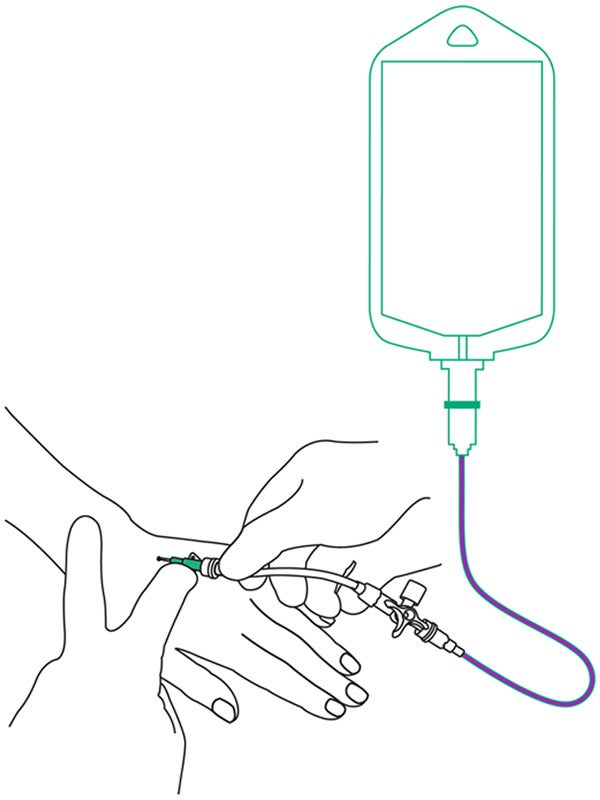You have successfully logged out.
Not registered yet?
Reducing Underdosing
Underdosage
a cause of medication errors

Medical Professional
This information is meant for medical professionals only. Please confirm that you are a medical professional before accessing the information.
Confirm Yes, I am a health care professional. Cancel No, I am not a health care professional.Medication error underdosage
Underdosage happens when patients do not receive the full dose of their prescribed drug. It is an often overlooked and underappreciated cause of medication errors. One cause of underdosage is the issue of the so-called dead volume. This describes a sometimes substantial amount of a prescribed intravenous drug remaining in the infusion set after the infusion, and thus never reaching the patient. Underdosage can lead to a decreased treatment response or treatment failure and may even contribute to the growing problem of resistances against antibiotic or anti-cancer treatment.
Did you know?
On average, a patient receives ten medications per day and will be subject to at least one medication error per day.1, 2 Studies investigating underdosing have shown even more worrying results:
- In case of 50ml infusions, up to 32.2% of the active agent in the residual volume remains in the IV line.3
- During antibiotic therapy, up to 50% of the drug are underdosed. 4
- In small-volume drug infusions, 10-32% of the prescribed dose may not be administered.5


On average, a patient receives 10 medications per day and will be subject to at least 1 medication error per day.1,2
Causes
Underdosing may arise due to errors in calculation or preparation of the drug.6 One often overlooked cause however is what literature refers to as either “dead volume” or “residual volume”. These terms actually mean the same thing, namely the (variable) volume of a prescribed drug that remains in the infusion system after the infusion has ended. Without taking measures to ensure that this volume is infused as well, the patients will not receive their full prescribed medication dose – with potentially adverse consequences such as inefficacy or resistance.7
Dead volume may vary greatly depending on the type of infusion system used, the length and diameters of the infusion tubing and the application of distributors (e.g. Y-connectors), which may also cause significant delays in drug administration, especially in small volumes and when using slow, concentrated infusions.8
Dead volume may be due to:
- Lack of awareness: 50% of HCW ignore dead volume.9
- Lack of clear local and national guidelines on the correct procedure on intravenous infusions.10
- IV administration sets not being routinely flushed.7
- Failure to prescribe carrier fluids/saline flushes means nurses may not be permitted to hang a carrier fluid.11
Health Consequences
Underdosing can result in therapy failure in general.7
Poor response to / failure of therapy: Calculations performed at Hull University showed that of an antibiotic regime prescribed for 12 weeks, an underdosage of 16ml per infusion set resulted in the equivalent of 12 missed doses, with “major concern of the impact this could potentially have on clinical outcomes, such as driving antibiotic resistance and undertreating infections”.12
- In antibiotic therapy, underdosing can result in the emergence of resistant organisms.13 In the US, resistance to antibiotics cause an estimated 2,8 million illnesses and more than 35,000 deaths per year.14
- Unrecognized underdosing leads to an almost 20% relative reduction in survival for women receiving adjuvant chemotherapy for breast cancer.15
And of course, underdosing is a Medication Error, and these are associated with life-threatening complications and death.16
Financial Consequences
The health consequences mentioned will inevitably be associated with longer patient recovery, more drugs needed, a waste of staff time and a waste of money spent on non-effective equipment and drugs.4 Studies confirm this assumption: Researchers at Hull University Teaching Hospital (UK) estimated that the unintentional underdosing of intravenous antibiotics led to a waste of £9.09 per set (appr. 1,500 antibiotic doses per year), amounting to a drug wastage level calculated at close to £14,000 per year.12
Preventive Strategies
Educate staff/raise awareness about the problem of underdosage: In one study, oncology was the only area where flushing was standard practice, in other areas it was optional.17
Use microbore administration sets to minimize dead volume.18
Flushing: Intravenous infusion sets should be routinely flushed with an adequate set to ensure the application of the full drug amount.19
- Caution: Volume used for flushing should be minimized in fluid-restricted patients.
- Caution: Flush with a compatible fluid (NIVAS Guidelines on in-line flushing).20
Use sets whose inherent design ensures that the residual volume is reduced to an absolute minimum.
(last access June 2021)
[1] Toh, M. R., Teo, V., Kwan, Y. H., Raaj, S., Tan, S. Y., & Tan, J. Z. (2014). Association between number of doses per day, number of medications and patient’s non-compliance, and frequency of readmissions in a multi-ethnic Asian population. Preventive Medicine Reports, 1, 43-471. This study investigated whether the number of doses per day and the number of medications are significantly associated with the number of readmissions.
[2] Hughes, R. G. (Ed.). (2008). Patient safety and quality: An evidence-based handbook for nurses. Rockville, MD: Agency for Healthcare Research and Quality; U.S. Department of Health and Human Services.
[3] Plagge, H., Golmick, J., Bornand, D., & Deuster, S. (2010). Evaluation of the dead volume in intravenous short-term infusion. EJHP Science, 16, 31-37.
[4] NHS England. (2015). Are you under infusing IV antibiotic infusions? Sign up to Safety Webinar https://www.england.nhs.uk/signuptosafety/wp-content/uploads/sites/16/2015/11/su2s-infusing-iv-antibiotics-webinar.pdf
[5]. Cousins, D. (2018). Patients are being underdosed: we need new guidance on small-volume drug infusions. Clinical Pharmacist, 10(12), 356-357.
[6] J.K. Aronson, Medication errors: what they are, how they happen, and how to avoid them, QJM: An International Journal of Medicine, Volume 102, Issue 8, August 2009, Pages 513–521, https://doi.org/10.1093/qjmed/hcp052
[7] Cooper, D.M., Rassam, T., & Mellor, A. (2018). Non-flushing of IV administration sets: an under-recognised under-dosing risk. British Journal of Nursing, 27(14)
[8] Gregerson, B.G., Harrison, S.K., Garrett, J.S., Kohman, K.N., & Kline, J.A. (2018). Comparison of outcomes in patients with intracranial hemorrhage on factor Xa inhibitors versus vitamin K antagonists treated with 4-factor prothrombin complex concentrate. Proceedings (Baylor University Medical Center), 31(2), 153-156.
[9] Chan, Y. K., Chan, A. H., & Wong, A. K. (2013). A novel approach for the detection of atrial fibrillation in single lead ECG using statistical features and random forest. CMBES Proceedings, 36(1), 1–4. 1.
[10] Cousins, D. (2018). Patients are being underdosed: we need new guidance on small-volume drug infusions. Clinical Pharmacist, 10(12), 356–357.
[11] Hidden Medication Loss When Using a Primary Administration Set for Small-Volume Intermittent Infusions.” Institute For Safe Medication Practices. December 3, 2020 https://www.ismp.org/resources/hidden-medication-loss-when-using-primary-administration-set-small-volume-intermittent
[12] MacLachlan L et al, Antimicrobial Stewardship – Ensuring full prescribed Dose Delivery of IV Antibiotics in OPAT, Hull University Teaching Hospitals, NHS Trust
[13] Fish, D., & Ohlinger, M. (2006). Antibiotic resistance among bacteria: One of the world’s most serious health problems. In “Molecular characterization of multidrug-resistant avian pathogenic Escherichia coli isolated from poultry and poultry products” by Deshmukh, O., Suryawanshi, R., Kurkure, N., Kaore, M., Badar, S., Shinde, O., Awandkar, S., & Gaikwad, N. Indian Journal of Animal Sciences, 93(5), 431–436
[14] Centers for Disease Control and Prevention. (2019). Antibiotic Resistance Threats in the United States, 2019 retrived from CDC 2015, https://www.cdc.gov/drugresistance/biggest-threats.html
[15] Gurney, H. (2002). How to calculate the dose of chemotherapy. British Journal of Cancer, 86(8), 1297-1302.
[16] Bowman, S., Raghavan, K., & Walker, I.A. (2013). Residual anaesthesia drugs in intravenous lines—a silent threat? Anaesthesia, 68(6), 557-561.
[17] Cooper, D.M., Rassam, T., & Mellor, A. (2018). Non-flushing of IV administration sets: an under-recognised under-dosing risk. British Journal of Nursing, 27(14).
[18] Institute For Safe Medication Practices. (2021). Additional Strategies to Improve Complete Delivery of Small-Volume Intermittent Infusions. Retrieved from https://www.ismp.org/resources/additional-strategies-improve-complete-delivery-small-volume-intermittent-infusions
[19] Peyko, V., An unrecognized Problem in Optimizing Antimicrobial Therapy: Significant Residual Volume Remaining in Intravenous Tubing With Extended-Infusion Piperacillin-Tazobactam, 2021 Journal of Pharmacy Practice Vol. 0.0 1-4.
[20] National Infusion and Vascular Access Society (NIVAS). (2019). Intravenous Infusion Drug Administration: Flushing Guidance. Retrieved from NIVAS-Flushing-gudiance-2019-final.pdf



